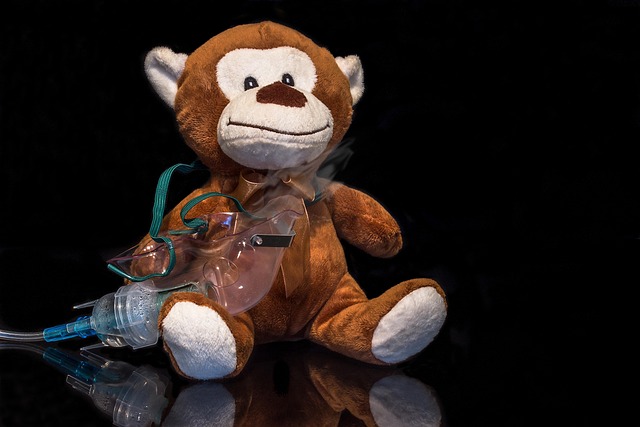Medical imaging for lung and chest examinations is vital for COPD diagnosis, providing insights into inflammation, lung damage, and airway obstruction through X-rays, CT scans, and MRI. These techniques enable accurate diagnoses, differentiate COPD from other conditions, facilitate personalized treatment plans, enhance diagnostic accuracy, and improve overall symptom management.
Chronic obstructive pulmonary disease (COPD) is a prevalent respiratory condition, and accurate diagnosis is crucial for effective management. Medical imaging plays a pivotal role in this process, offering various techniques to visualize and assess lung structures. This article explores the different imaging aids used to diagnose COPD, focusing on X-rays and CT scans as foundational tools, while also highlighting advanced technologies that provide comprehensive evaluations. Understanding these imaging techniques empowers healthcare professionals to make informed decisions.
Understanding Imaging Techniques for COPD Diagnosis
Medical imaging plays a pivotal role in diagnosing Chronic Obstructive Pulmonary Disease (COPD), providing detailed insights into the lungs and chest area. Techniques such as X-rays, CT scans, and MRI are instrumental in detecting the characteristic signs of COPD, like inflammation, lung damage, and airway obstruction. These advanced imaging methods allow healthcare professionals to visualise the extent of lung inflammation, identify emphysema, and assess the overall architecture of the lungs.
By analysing these images, doctors can make accurate diagnoses, differentiate COPD from other respiratory conditions, and develop tailored treatment plans. The use of medical imaging for lung and chest examinations enhances diagnostic accuracy, enabling early intervention and better management of COPD symptoms.
X-rays: Uncovering Lung Abnormalities
Medical imaging plays a pivotal role in diagnosing Chronic Obstructive Pulmonary Disease (COPD), providing critical insights into lung and chest abnormalities. Among the various techniques, X-rays are a common initial step due to their accessibility and cost-effectiveness. These images capture the overall structure of the lungs, allowing healthcare professionals to identify key indicators such as hyperinflation, collapsed lungs, or the presence of fluid in the alveoli.
By analyzing X-ray results, doctors can make informed decisions about further testing. Irregularities like streaks or opacities may suggest emphysema or bronchitis, enabling them to differentiate between COPD subtypes and plan tailored treatment strategies. Advanced medical imaging technologies, such as high-resolution computed tomography (HRCT), offer even more detailed insights into lung anatomy, helping in precise diagnosis and monitoring the progression of COPD over time.
CT Scans: Detailed Assessment of Airways and Lungs
Computed Tomography (CT) scans play a crucial role in diagnosing and assessing Chronic Obstructive Pulmonary Disease (COPD). This advanced medical imaging technique provides detailed, high-resolution cross-sectional images of the lungs and chest area. Through CT scanning, healthcare professionals can meticulously examine the airways, lungs, blood vessels, and surrounding structures, offering a comprehensive overview that aids in identifying COPD-related changes.
The intricate details revealed by CT scans enable doctors to detect narrowing or obstruction in the airways, emphysema (a condition characterized by loss of lung tissue elasticity), and the presence of airway inflammation—all key indicators of COPD. Additionally, these images can help identify complications such as pneumonia, pulmonary fibrosis, or the formation of abnormal growths, which may contribute to the overall severity and management of COPD.
Advanced Imaging Technologies for Comprehensive Evaluation
Advanced imaging technologies play a pivotal role in the comprehensive evaluation of chronic obstructive pulmonary disease (COPD). Medical imaging for lung and chest provides detailed insights into the structural changes and functional impairments associated with this condition. Techniques such as high-resolution computed tomography (HRCT) offer exquisite anatomical detail, enabling radiologists to identify emphysema, airway remodeling, and bronchiolitis, which are hallmarks of COPD.
These advanced imaging methods go beyond what can be observed through conventional chest X-rays or physical examination. They allow for quantitative measurements of lung damage, assessment of airway narrowing, and detection of small air spaces or pulmonary nodules that might be missed with less sophisticated methods. By utilizing medical imaging for lung and chest, healthcare providers gain valuable tools to stage COPD severity, monitor disease progression, and tailor treatment strategies accordingly.
Medical imaging plays a pivotal role in diagnosing chronic obstructive pulmonary disease (COPD), offering insights beyond what can be seen through simple clinical examinations. Techniques like X-rays, CT scans, and advanced imaging technologies provide detailed assessments of the lungs and airways, helping healthcare professionals make accurate COPD diagnoses. By unmasking lung abnormalities and enhancing our understanding of chest structures, these imaging aids enable comprehensive evaluations that guide effective treatment strategies for patients with COPD.
